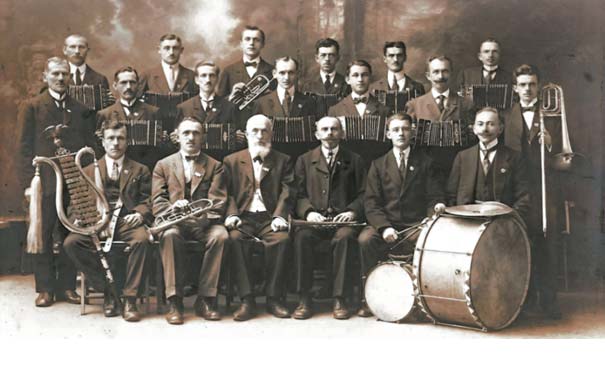
The concertina was popular with labourers and miners, as it was possible to learn to play it as a musical layman without any knowledge of sheet music.
Uhlig developed a number system in order to offer those unfamiliar with music a learning aid. The company C.F. Uhlig also sold the corresponding training material.
A fingering system specially designed for this instrument, the so-called “Waschleinensystem” (washing line system), in which numbers for the keys were attached to a single line, made it possible to play music by numbers. The instrument was therefore also known as the “miner’s piano” or the “little man’s piano”.
Regional folk music was played and, with the rise of the labour movement, also proletarian battle songs.
For a long time, Saxony was one of the strongholds of concertina music. Chemnitz, as the cradle of the concertina, therefore played a special role.

Over the years, there have been a total of 40 bandoneon and concertina clubs in the Chemnitz city area alone, 20 of which were active in the 1920s.
Based on the current city area, there were at least 14 other harmonica clubs, including 4 in Reichenbrand, 1 in Siegmar, 1 in Schönau, 2 in Kappel, 1 in Rabenstein, 1 in Reichenhain, 1 in Euba, 1 in Erfenschlag, 1 in Harthau and 1 in Markersdorf.
Source: Karl Georg Schroll: Bandonionvereine – vereint – beliebt – vergessen.
Although the first Chemnitz concertina club is not included in this list, the first German harmonica club was founded in Chemnitz in 1874. This can be concluded from a diploma of honour presented by the specialist journal Die Volksmusik on the occasion of the 50th anniversary of this club. It was probably the “Harmonikaclub Chemnitz”.
In the Weimar Republic, there were around 30,000 bandoneon and concertina players organised in around 1,200 clubs across Germany.


The “Deutsche Konzertina und Bandoneon Bund” (German Concertina and Bandoneon Association) was founded in 1911 as an umbrella organisation.
The “Erzgebirgische Konzertina und Bandoneon Bund” (Concertina and Bandoneon Club of the Ore Mountains) was founded in 1924 and entered in the register of associations on 17 June 1926. It was based in Chemnitz.
Members of the federal association could use the performance rights acquired by the association and sheet music was made available to members at half the purchase price, depending on the circumstances of the federal treasury.
According to its statutes, the association was based on the German labour movement.
In 1926, the national conference was held to mark the 15th anniversary of the German Concertina and Bandoneon Association.
In 1927, the umbrella organisation had around one thousand concertina and bandoneon clubs with 14,000 members. At that time, there were more harmonica clubs than football clubs in Germany!
While the global economic crisis had already taken its toll on clubs, the Nazi era led to the dissolution of clubs.
The first signs of the clubs’ disbanding could already be observed in Chemnitz shortly after Hitler had come to power.
Because of its close ties to the labour movement, the concertina and bandoneon clubs were a thorn in the side of the Nazis. They declared the instruments to be “unsuitable for folk music”.
The German Concertina and Bandoneon Association was banned in 1935.
Individual clubs were ‘brought into line’ and many disbanded as a result.
As an example, the Chemnitz association “Edelweiß” was liquidated on 1 April 1935 at its own request “in order to join the large national community created by the Reich…”.
This resulted in a falling demand for concertinas and bandoneons, bringing the German harmonica industry to an almost complete standstill.
Even after the Second World War, these instruments hardly played a major role because the accordion, which was easier to play, had become established in the meantime.

